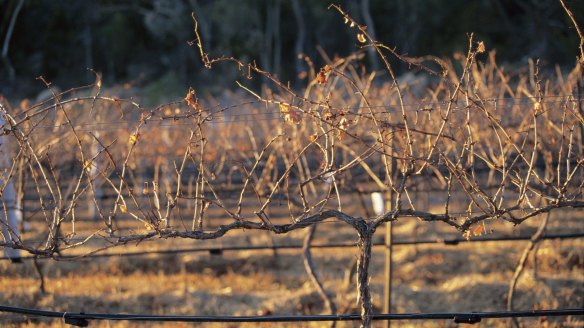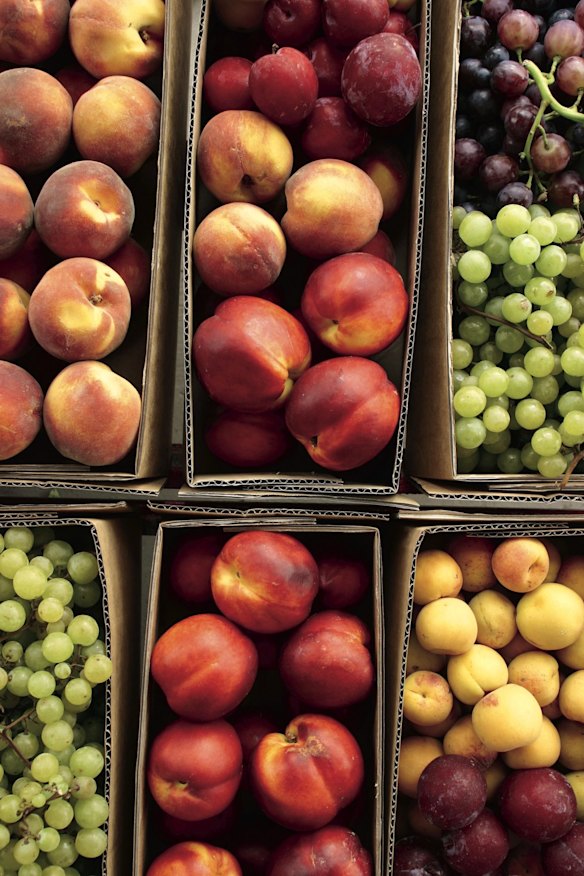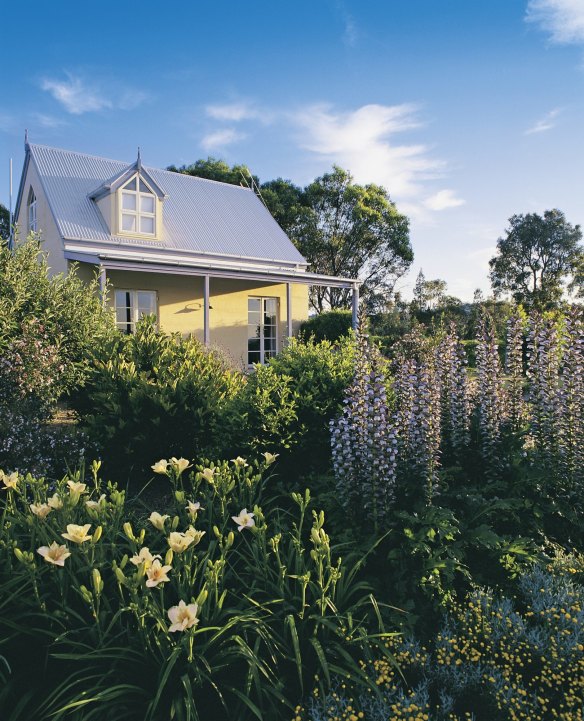Among the vines in Queensland's Granite Belt

Zip along the New England Highway at Queensland's southeast edge and you could easily blow right through Stanthorpe, leaving a swirl of dry eucalyptus leaves and cockatoos' cackles in your wake. Lift your lead foot, though, and this handsome country town provides eccentric surprises: an art gallery, a heritage trail, a curious totem pole made of wine barrels, and a sculpture depicting a brass monkey.
The public art hints at what this region offers. The Granite Belt, which runs along the NSW border and straddles the Great Dividing Range, sits at an average altitude of 800 metres, which brings frosty winters and occasional snowfall. The brass-monkey weather, coupled with granite soils, make this ideal country for stone fruit and grapevines. The wines are interesting, the food tied to the seasons and, as a bonus, Girraween and Sundown national parks are tumbled with giant granite boulders amid a buxom bevy of hills.
Stanthorpe should be your first encounter with the emerging Granite Belt wine region for its state-of-the-art Queensland College of Wine Tourism, the only place of its kind in the world. If you're keen, take a hands-on "Winemaker for the Weekend" course here to learn about wine production, from grape-picking to fermentation and bottling.

The college's student-run wine cellar and bistro showcases dishes made from seasonal local ingredients, from springtime peas to summer eggplant and haloumi from nearby Eukey. Autumn tempts with figs, Amiens rabbit and Severnlea pumpkins and warms your cockles with the likes of lamb hotpot. Dishes are matched with the college's own wines from Banca Ridge Winery beyond the windows.
This is just one of 50-odd cellar doors in the Granite Belt, proving that wine and Queensland aren't as mismatched as you might imagine. In fact, conditions mimic those in some of Europe's foremost wine regions, such as France's Rhone Valley and northern Spain's Rioja.
Mainstream grape varieties such as shiraz, semillon and cabernet sauvignon account for most production, but unusual grapes are the reason to visit. In 2007, local winemakers Jim Barnes of Hidden Creek Winery and Peter McGlashan of Ridgemill Estate set out to promote alternative Mediterranean grape varieties. Their Strange Bird concept soon garnered international attention.

A map guides visitors to a host of wineries nurturing Strange Birds, as varieties accounting for less than one per cent of the countries bearing vines are known here. Cellar doors acquaint visits with wines made from barbera, mourvedre, durif, nebbiolo, tempranillo and sangiovese.
At Ballandean Estate, south of Stanthorpe, you can try even less common cold-climate varietals saperavi (native to Georgia) and Germany's sylvaner, which produces a crisp, honeyed white suited to cheese plates.
Established in the 1940s by the immigrant Italian Puglisi family and still family owned, Ballandean is one of Queensland's best-known wineries. As you'll discover on a tour, sylvaner was introduced when the wrong cuttings were delivered to the vineyard.
Settle in for a meal at the winery's restaurant, The Barrelroom, surrounded by the oaky gurgle of 120-year-old port barrels. Organic pastrami, seared Spanish mackerel and wild venison with cauliflower and fig might be on the menu, all sourced within three hours of the restaurant.
Is nearby Symphony Hill the region's best winery? You decide, preferably by quaffing some of its lauded Wild Child Viognier, which winemaker Mike Hayes describes as having "a scandalous reputation for being brazenly different". Hayes grew up here – he admits to having his first kiss on the tennis court – but planted grapes only in 1996 and has bagged awards ever since.
Ballandean is a good base for exploration since it's also near Granite Belt national parks. You could also abandon grapes for cocoa beans at Wisteria Cottage in Wyberba, where Alba Conti makes some 30 varieties of Belgian chocolate, flavoured with the likes of lemon myrtle or cabernet sauvignon. In winter, hot chocolates are laced with hazelnut, mint or caramel.
As befits an increasingly interesting wine region, the food focus is growing. Puglisi family son-in-law Ian Henderson noticed on a European trip that many winemakers also produced vinegar, and returned with an obsession. His business, Lirah Vinegar, now produces impressive artisan vinegars such as caramelised-apple balsamic, cabernet and chardonnay, barrel-aged for two years.
As you swing back towards Stanthorpe you could also easily be tempted by The Bramble Patch in Glen Alpin, which produces jellies, relishes and spicy tomato kasoundi from local fruit, and dishes up Dutch-style poffertjes pancakes piled with ziggurats of blackberries and cream.
Further on at Severnlea you can get back on the wine trail at Ridgemill Estate, which produces a silky saperavi hinting of cherry and plum. Whiskey Gully Wines, housed in an 1880s homestead, tends to more mainstream wine varieties but has fruity, fragrant colombard. Originating in France but widely grown in California and South Africa, colombard is a good match for salads, seafood and Asian dishes.
Around Amiens, west of Stanthorpe, stop at Robert Channon Wines for Spanish-inspired tortilla, prawns in garlic and pistachio tart with rose-petal bark. Then drift on to Ravens Croft Winery, where winemaker Mark Ravenscroft is often spotted in aviator glasses and an Akubra hat. Trained in South Africa, he worked in South African and Australian wineries (including Ballandean) before starting his own label in 2004. It produces good verdelho and interesting South African red grape variety pinotage, which has an unusual earthy, smoky flavour.
North of Stanthorpe tends more towards apples and pears. The Summit has the distinction of being the coldest pace in Queensland (it can snow in winter) and has Australia's highest railway, used for shipping fruit. Villages such as Dalveen and Thulimbah are littered with colonial-era train stations, fire stations and schools. Summit Estate provides elegant Strange Bird varieties such as malbec and marsanne, introduced here by Argentine-born, Europe-trained winemaker Paola Cabezas Rhymer.
A Big Apple atop a pole signals you've arrived in Thulimbah. You can pick your own apples at Sutton Juice Factory from among 30 varietals such as jonathon, mutsu, sundowner and pink lady. Meanwhile Stanthorpe Cheese produces the region's only hard cheeses. Cheesemaker Karen Deeth grazes her own land, produces her own milk and makes the cheese herself, naming some with a nod to the Granite Belt's cool climate: Snowfall Brie, Brass Monkey Stilton.
Pungent soft cheese Rosco's Rough Red is named after her partner, Ross Burnett. Ignore the aroma, because it tastes marvellous. You can design your own tasting plate here with a glass of petit verdot wine to match. Rosellas tumble through the trees in scarlet and blue, cackling in glee. The air is nippy, and Granite Belt life is good.
DETAILS
Queensland College of Wine Tourism, qcwt.com.au
Hidden Creek Winery, hiddencreek.com.au
Ridgemill Estate, ridgemillestate.com
Ballandean Estate, ballandeanestate.com
The Barrelroom, barrelroom.com.au
Symphony Hill, symphonyhill.com.au
Wisteria Cottage, wisteriacottage.com.au
Lirah Vinegar, lirah.com.au
The Bramble Patch, bramblepatch.com.au
Whiskey Gully Wines, whiskeygullywines.com.au
Robert Channon Wines, robertchannonwines.com
Ravens Croft Winery, ravenscroftwines.com.au
Summit Estate, summitestate.com.au
Sutton Juice Factory, suttonsfarm.com.au
Stanthorpe Cheese, stanthorpecheese.com.au
Brian Johnston travelled at his own expense.
Restaurant reviews, news and the hottest openings served to your inbox.
Sign up